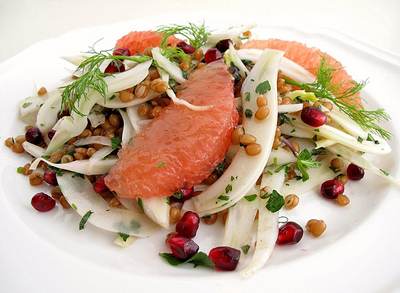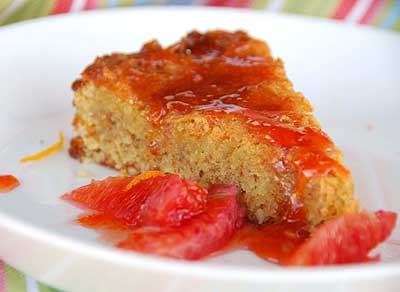 If it wasn't for citrus fruit, winter's selection of produce would be pretty sad and boring. Once you've had your share of squashes and root vegetables, it's time for something different. Citrus offers a welcome respite. When markets begin to overflow with oranges, lemons, limes, and grapefruit, things finally get exciting. You may even see unusual citruses, such as blood oranges, tangelos, and pomelos. I love them all, but I particularly adore the sweet-tart flavor of grapefruits. This time of year, they replace my apple-a-day routine. But grapefruits aren't just for a dessert or snack, they shine in savory dishes, like this salad.
If it wasn't for citrus fruit, winter's selection of produce would be pretty sad and boring. Once you've had your share of squashes and root vegetables, it's time for something different. Citrus offers a welcome respite. When markets begin to overflow with oranges, lemons, limes, and grapefruit, things finally get exciting. You may even see unusual citruses, such as blood oranges, tangelos, and pomelos. I love them all, but I particularly adore the sweet-tart flavor of grapefruits. This time of year, they replace my apple-a-day routine. But grapefruits aren't just for a dessert or snack, they shine in savory dishes, like this salad.
The classic fennel and grapefruit salad is a wonderful combination. Crunchy and sweet anise-flavored fennel goes well with the tart citrus flavor of grapefruit. This recipe reinvents the salad by adding wheat berries for a wholesome twist. The actual grains of wheat—the berries, as they are called—come in hard and soft varieties, where the hard is higher in protein and the soft higher in starch. Both work fine in this recipe. Once cooked, the berries are chewy on the outside, but tender on the inside. Enjoy them as a side dish like a pilaf or add them to any salad. They are especially nice in this recipe as they absorb the vinaigrette and grapefruit juices.
Winter
Winter
Feeling Blue? Eat Italian Almond Torte with Blood Orange Compote
 It's March, and the weather is still pretty miserable. There are cold fronts, snow storms, dense fog, and freezing rain blanketing various parts of the country.
It's March, and the weather is still pretty miserable. There are cold fronts, snow storms, dense fog, and freezing rain blanketing various parts of the country.
While I can't make the daffodils grow any more quickly, I can share a recipe for a refreshing Italian Almond and Orange with Blood Orange Compote that is sure to make you feel warm and happy. I created the recipe a few weeks ago and have since made it two more times. It's that good.
While this Italian torte bakes, your home will be filled with the bright scent of citrus. Since it's subtly sweet yet rich with almond flavor, it's ideal for pairing with a glass of Italian Vin Santo on a relaxing afternoon. It also makes a lovely formal dessert when dressed with a spicy compote of tart blood oranges soaked in honey, vanilla, cloves, and star anise.
Roasted Sweet and Spicy Butternut Squash
 Another workhorse of a vegetable, Butternut Squash is always on my shopping list and in my inventory during the fall and winter months.
Another workhorse of a vegetable, Butternut Squash is always on my shopping list and in my inventory during the fall and winter months.
Sometimes it’s tucked into a curry, sometimes it’s a soup or pureed but, most of the time, it’s simply roasted with cayenne, cinnamon and salt and then drizzled with sugar free maple syrup (which has just 20 calories instead of 200!)
It’s not only a delicious side dish with dinner, it’s a satisfying snack to take on the run, or a great way to top a spinach, walnut and cranberry salad the next day. Believe it or not, I even have it for breakfast sometimes because its cinnamon-y and syrupy warmth reminds me of hot cinnamon rolls!
And this is also another one of those one oven/one time dishes which makes it easy to build your inventory!
Crispy Millet Kale Cakes
 Without being super conscious about it, I have been making more and more vegetarian meals. Millet, lentils, quinoa, black beans, and lots of green vegetables are consumed weekly while less meat and chicken grace our dinner table. Don’t get me wrong, I like my animal protein. As long as it is pastured and raised in an environment that you and I would want to be raised in.
Without being super conscious about it, I have been making more and more vegetarian meals. Millet, lentils, quinoa, black beans, and lots of green vegetables are consumed weekly while less meat and chicken grace our dinner table. Don’t get me wrong, I like my animal protein. As long as it is pastured and raised in an environment that you and I would want to be raised in.
Last winter, when we switched over to a gluten free diet, I cleaned out the pantry. I was amazed at how much food I had on hand and I realized that I could feed my family for a month based on the existing inventory.
In that inventory, there was an unopened bag of millet. I have always liked millet but pretty much forgot about it. Instead, I was making a lot of farro, quinoa, and barley. Quinoa is one of the few grains that we continued to eat and I decided to open that bag of millet and start experimenting.
Blood Orange Marmalade
 About 6 weeks ago my friend Mary, emailed me to say that her blood oranges from her tree(yeah-she has a tree) were almost ripe and wanted to drop some off for me to enjoy. I was elated and anxiously awaited the bag.
About 6 weeks ago my friend Mary, emailed me to say that her blood oranges from her tree(yeah-she has a tree) were almost ripe and wanted to drop some off for me to enjoy. I was elated and anxiously awaited the bag.
One morning, upon arriving home from a yoga class, there on my doorstep, was HUGE bag of blood oranges and their leaves. I washed and dried the oranges and put them in a vessel and placed them on my dining room table. It took me days to figure out what I was going to make with them, but I wasn’t in a rush. I was merely enjoying their abundance.
More Articles ...
Welcome to the new One for the Table ...
Our Home Page will be different each time you arrive.
We're sure you'll find something to pique your interest...


